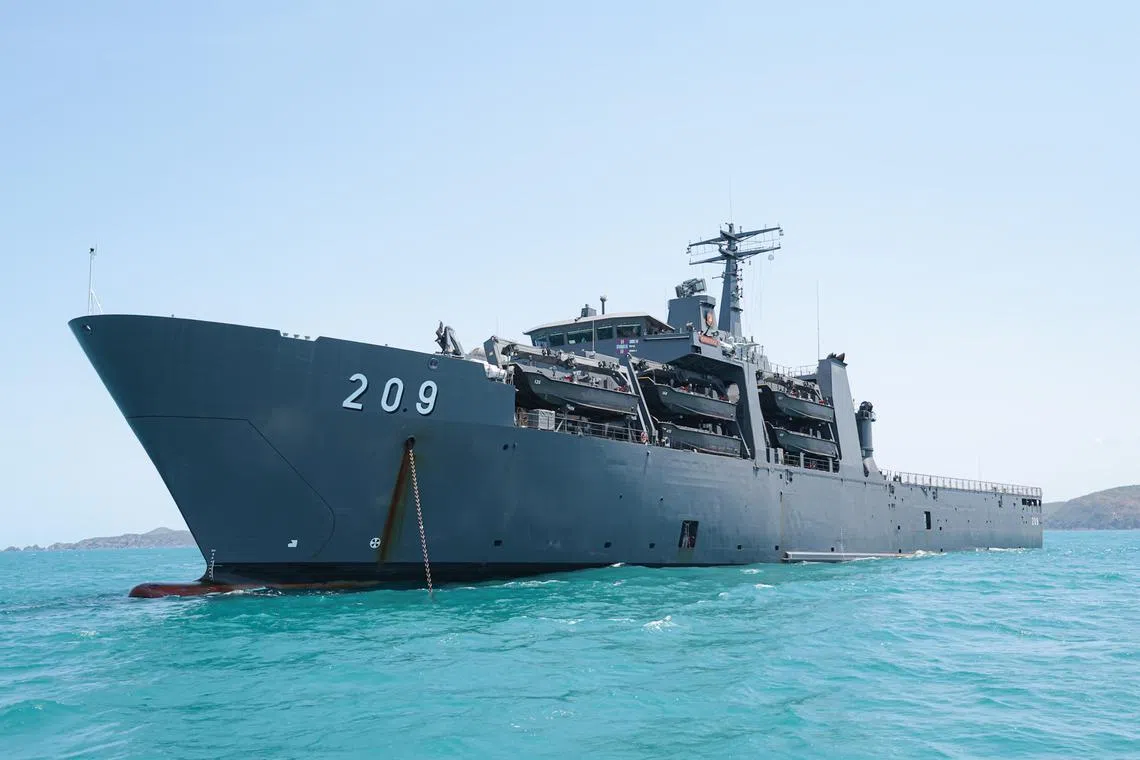Army, Navy, Air Force personnel share experience living and working on same warship during Exercise Trident
Sign up now: Get ST's newsletters delivered to your inbox
![CMG20241109-JasonLee01/李冠卫/张佳莹/OA trip: Exercise Wallaby 2024 [Rockhampton]
Profile photos: CFC Lim Shi Xian [Marksman HQ Platoon, 3 Guards] & CPL Lim Shi Rong [Fast Craft Specialist]](https://cassette.sphdigital.com.sg/image/straitstimes/990127f9f6d2398b4750b15b4036dce673f0b7d4ae0ffd071e30f6fe2c4ca273)
Corporal Lim Shi Rong (left) and his brother, Corporal First Class Lim Shi Xian, were stationed on the same ship.
PHOTO: LIANHE ZAOBAO
Follow topic:
SHOALWATER BAY TRAINING AREA, AUSTRALIA - At 141m long with a displacement of 6,000 tonnes, landing ship tanks (LSTs) like the RSS Persistence are the largest ships with the Republic of Singapore Navy (RSN), capable of completing a variety of missions.
For the RSS Persistence, this has included providing disaster relief to Indonesia’s Aceh province following the 2004 Indian Ocean earthquake and tsunami, joining multinational anti-piracy patrols in the Gulf of Aden, and carrying out search and rescue missions in the Java Sea following the crash of AirAsia Flight 8501 in 2014.
Bringing together Singapore Armed Forces (SAF) servicemen from different services on missions, it has now reunited two brothers in Australian waters, thousands of miles from home.
In Freshwater Bay off Australia’s east coast, Corporal Lim Shi Rong, 21, a platoon marksman with the 3rd Battalion Singapore Guards grinned as he saw Corporal (First Class) Lim Shi Xian, 22, a fast craft specialist with the RSN.
CFC Lim said he was excited when he learnt that he and his younger brother would be stationed on the same ship, as it would be his first meeting with a family member since he left Singapore almost a month ago.
The bay, part of the Shoalwater Bay Training Area, is where the bilateral Exercise Trident is taking place
The exercise involves more than 1,900 personnel from Singapore and Australia, and will see troops and vehicles being ferried ashore from the RSS Endurance and RSS Persistence LSTs on board fast craft and Republic of Singapore Air Force (RSAF) helicopters to complete missions inland.
For CPL Lim, being on the LST was an opportunity to see his brother at work. “In the army, we don’t often get a chance to see how the navy works, and this has been an interesting experience.”
The Straits Times was part of a media group that was taken on board the RSS Persistence for an overnight stay during the exercise.
Reporters saw various shipboard operations, including how sailors kept watch through the night while anchored offshore, as well as the launching and recovery of helicopters and fast craft.
Exercise Trident marks the first time some soldiers like Third Sergeant (NS) Mohd Nazrul Mohd Yazid are joining an overseas exercise by the SAF, and seeing its personnel across service branches working side by side.
A pharmaceutical biotechnologist in civilian life, 3SG Nazrul has the role of fast craft equipment and personnel coxswain in the exercise, and is tasked with piloting a 13m-long craft as it moves troops and equipment to shore or between LSTs.
Despite the six-week deployment being by far the longest he has ever been away from family, he said it has been memorable so far.
“It is my first time seeing three services of the SAF working together as one, and it is a sight to see,” he added, referring to the army, air force and navy.
Adjusting to being on a ship for an extended duration was a challenge highlighted by Second Sergeant (NS) Bhaskar Guruprakash, a section commander of the Lighter Amphibious Resupply Cargo five-tonne wheeled amphibious vehicle company at the 3rd SAF Transport Battalion.

The RSS Persistence has provided disaster relief following the 2004 Indian Ocean earthquake and tsunami, joined multinational anti-piracy patrols off the Gulf of Aden, and carried out search and rescue in the Java Sea following the crash of AirAsia flight 8501 in 2014.
PHOTO: LIANHE ZAOBAO
He had joined the RSS Persistence in early November during its port visit in Brisbane before heading to Shoalwater Bay Training Area for the exercise, and took a while to get used to the unique vocabulary of his naval counterparts, such as calling the toilets on board “heads”.
2SG Guruprakash said he learnt something new every day while on board the RSS Persistence, and appreciated the work and safety culture of the sailors.
“It has been an eye-opener for me,” he added.


